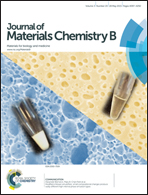Electrospun rubber fibre mats with electrochemically controllable pore sizes†
Abstract
Electroactive, elastomeric, microfiber mats that show controllable pore size variation upon electrochemical stimulation are produced from semi-interpenetrating polymer networks (s-IPNs). This type of porous, elastomeric scaffolds that are mechanically dynamic under electrochemical stimuli could find new applications in stretchable electronics, (bio)filtration, soft robotics and stimulation of biological cells. These microfiber mats are prepared in two simple steps. Firstly, a mixture of high molecular weight nitrile butadiene rubber (NBR) and cross-linking agent, poly(ethylene glycol)dimethylacrylate are electrospun with in situ cross-linking. Secondly, a conducting polymer poly(3,4-ethylenedioxythiophene) (PEDOT) is embedded into the electrospun fibres by oxidative chemical polymerization of EDOT-swollen microfiber mats. This two-step process affords robust, highly flexible and conductive s-IPN microfiber mats. The microfiber mat undergoes a controllable pore size variation upon applying an electrochemical stimulus in the form of a reduction–oxidation cycle to the mats in an electrolyte. The maximum average pore size variation, measured in situ using confocal microscopy, is 25%, achieved in 1 M lithium bis-trifluoromethanesulfonimide (LiTFSI) in propylene carbonate (PC) for a potential step between +0.6 V and −0.5 V (vs. Ag wire). These mats also show pore size variation in a biologically compatible solution, phosphate buffered saline.


 Please wait while we load your content...
Please wait while we load your content...